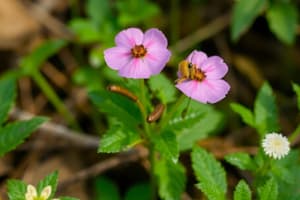Podcast
Questions and Answers
What is the main difference between commensalism and parasitism?
What is the main difference between commensalism and parasitism?
- In commensalism, one organism benefits while the other is unaffected, whereas in parasitism, both organisms benefit.
- In commensalism, both organisms benefit, whereas in parasitism, one organism benefits at the expense of the other. (correct)
- In commensalism, both organisms are harmed, whereas in parasitism, the host benefits from the parasite.
- In commensalism, both organisms benefit equally, whereas in parasitism, one organism harms the other.
Which of the following interactions involves an ant being controlled by a fungus to climb a plant and die?
Which of the following interactions involves an ant being controlled by a fungus to climb a plant and die?
- Competition
- Parasitism (correct)
- Mutualism
- Commensalism
What is the main characteristic of mutualism?
What is the main characteristic of mutualism?
- One organism benefits at the expense of the other.
- Both organisms benefit from the interaction. (correct)
- One organism is unaffected by the interaction.
- Both organisms are harmed by the interaction.
Which type of interaction is defined by two organisms competing for the same limited resource?
Which type of interaction is defined by two organisms competing for the same limited resource?
In which type of interaction does one species harm another without being affected itself?
In which type of interaction does one species harm another without being affected itself?
What occurs in intraspecies competition?
What occurs in intraspecies competition?
When cattle graze in grass and birds eat insects around them, what type of interaction is this an example of?
When cattle graze in grass and birds eat insects around them, what type of interaction is this an example of?
Flashcards are hidden until you start studying
Study Notes
Ecosystem Interactions
- Organisms use available resources in different ways to increase their chances of survival.
- Examples: birds use trees for shelter, insects use tree leaves for food.
Habitat
- A habitat is an area where an organism lives.
- Examples: an insect's habitat is a single tree, a bird's habitat is a grove of trees.
- Habitats may overlap with other organisms.
Niche
- A niche is the total role an organism has in its environment.
- It includes how an organism meets its specific needs for food and shelter.
- Example: a deer's niche is to feed on grass, become food for wolves, provide blood for mosquitoes, and fertilize soil.
- An ecological niche includes:
- What an organism feeds on
- What feeds on it
- How the organism behaves in its environment
- All the factors that the organism needs to survive, remain healthy, and reproduce
Habitat and Niche
- Habitat is the address of an organism.
- Niche is the occupation of an organism.
- The niche of an organism decides its habitat.
Community Interactions
- Organisms living in biological communities interact constantly.
- Each organism depends on other organisms and competes with other organisms.
- Types of interactions: competition, predation, symbiosis.
Competition
- Occurs when organisms need to use the same resource at the same time.
- Can occur within or between species.
- Types of competition: intraspecific (between organisms of the same species), interspecific (between organisms of different species).
- Limited resources that can lead to competition: food, space, sunlight, mates.
Predation
- The act of one organism consuming another organism for food.
- The organism that pursues is the predator.
- The organism that is pursued is the prey.
- Prey species have defences: speed, camouflage, physical defences, bad taste, poison, mimicry.
Symbiosis
- A relationship between members of two different species that live together in close association.
- Types of symbiosis: mutualism, commensalism, parasitism.
- Mutualism: both organisms benefit.
- Commensalism: one organism benefits and the other is not harmed.
- Parasitism: one organism benefits and the other is harmed.
Examples of Symbiosis
- Mutualism: clownfish and sea anemone, cleaner shrimp and moray eels.
- Commensalism: whales and barnacles, lichen and tree.
- Parasitism: fungus and ant, ophiocordyceps unilateralis and ants.
Other Interactions
- Ammensalism: harm to one species and no effect on the other.
- Examples: cattle grazing in grass, birds eating insects, but the cattle are unharmed.
Studying That Suits You
Use AI to generate personalized quizzes and flashcards to suit your learning preferences.




